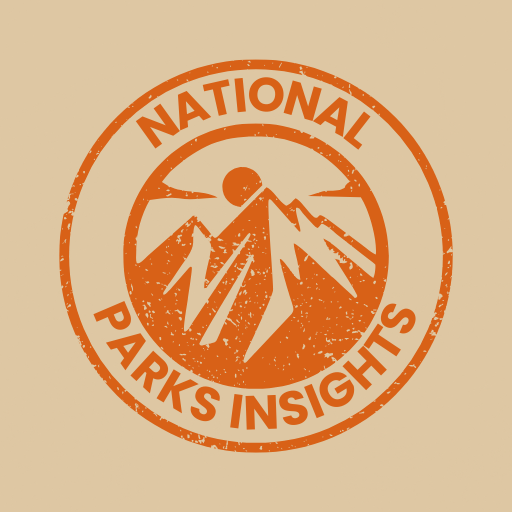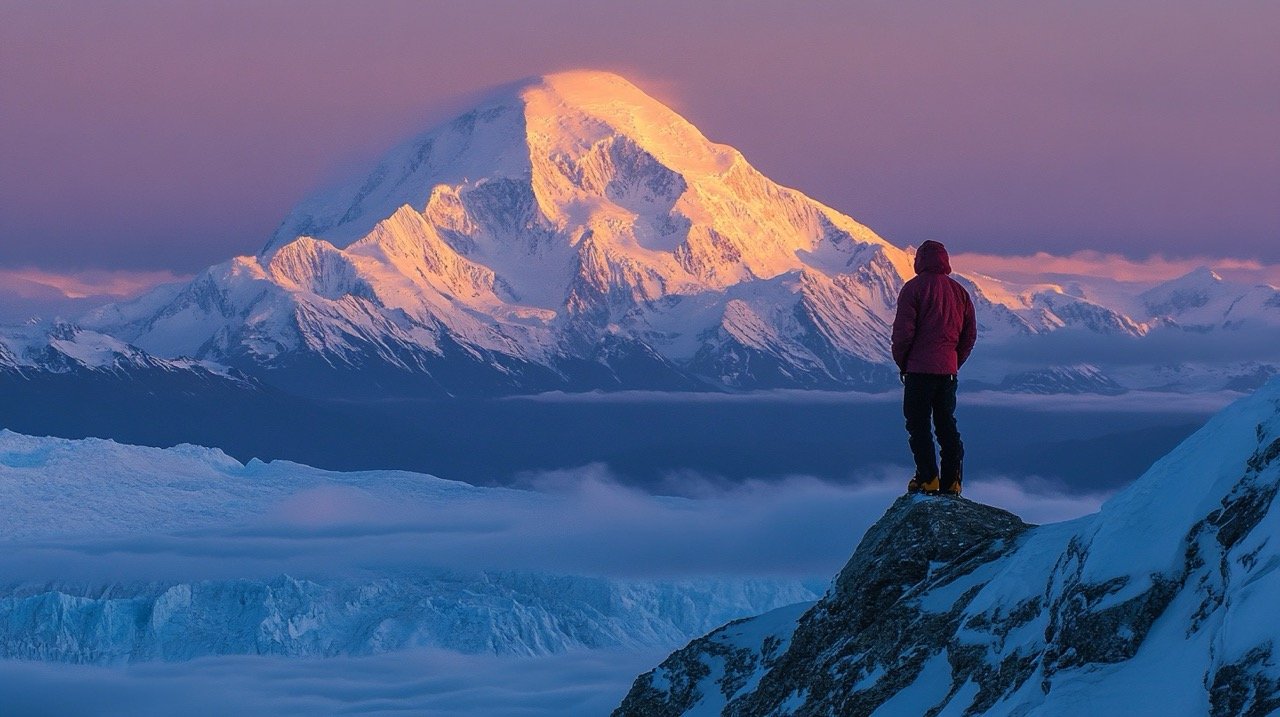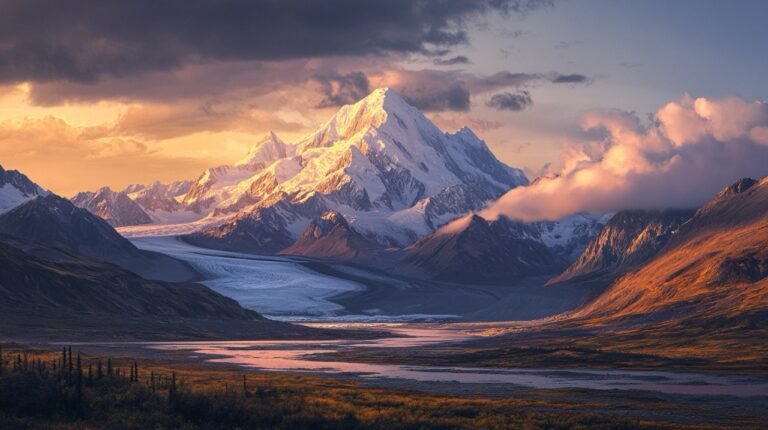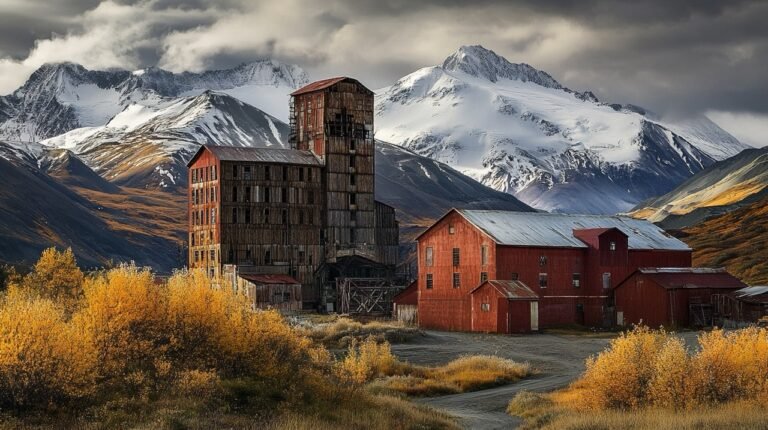Exploring Mount St. Elias
Overview of Mount St. Elias
Mount St. Elias, the second-highest peak in both Canada and the United States, is a jaw-dropping wonder of nature. Perched on the Yukon and Alaska border, it’s about 26 miles southwest of Mount Logan, Canada’s highest mountain. This colossal peak stands at 18,008 feet and is part of the Wrangell-St. Elias National Park and Preserve.
Location and Accessibility
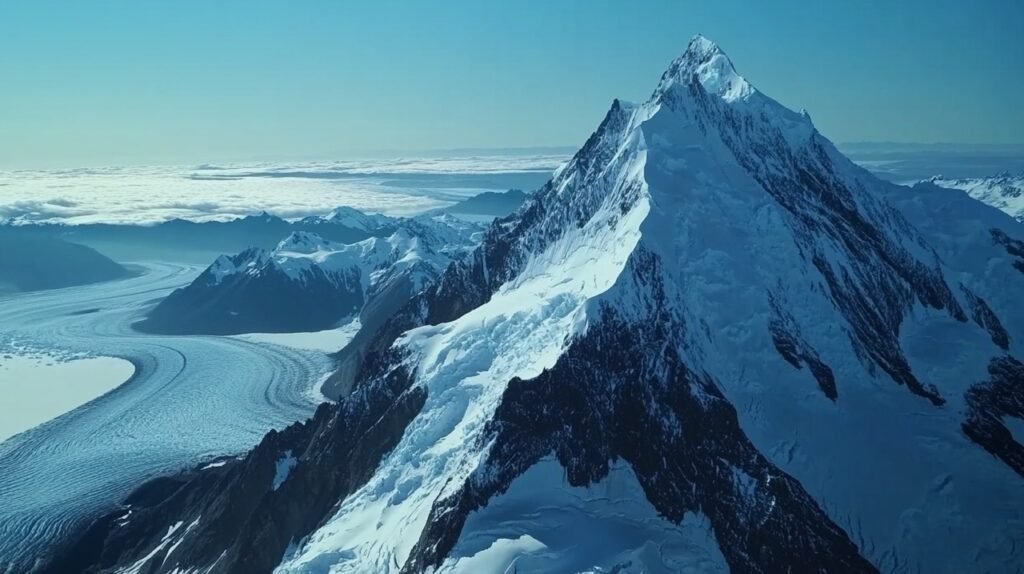
Mount St. Elias sits within the largest national park in the United States, Wrangell-St. Elias National Park and Preserve. This massive wilderness is a playground for thrill-seekers and nature lovers. The park’s landscape is a mix of towering peaks, volcanoes, glaciers, and rivers, making it a geologist’s dream come true.
Getting to Mount St. Elias is no walk in the park. The mountain’s south side shoots up from the Pacific Ocean, just 20 miles from its summit. This closeness to the ocean means the peak often faces storms and strong winds, adding to the challenge of climbing it.
| Feature | Details |
|---|---|
| Elevation | 18,008 feet |
| Location | Yukon and Alaska border |
| Nearby Peak | Mount Logan |
| Distance from Ocean | 20 miles |
To reach Mount St. Elias, start your journey from Anchorage, Alaska. From there, catch a flight to Yakutat, one of the nearest towns to the mountain. Yakutat has limited services, so make sure you’re well-stocked with supplies and gear.
Another cool spot to check out is the Kennecott Mines within the park. These mines offer a peek into the area’s rich mining history. From Kennecott, you can join guided tours or expeditions to get closer to Mount St. Elias.
For more details on the park’s location and how to get there, visit our guide on Wrangell-St. Elias Alaska.
Exploring Mount St. Elias is an adventure you won’t forget. From its towering heights to its rugged terrain, this majestic peak promises excitement and breathtaking beauty. Whether you’re a seasoned climber or just love nature, Mount St. Elias has something awe-inspiring for everyone.
Click here to see Beautiful Hotel Options at Wrangell St. Elias
History and First Ascent
Mount St. Elias, a true gem in Wrangell-St. Elias National Park, has been a magnet for explorers and climbers for over a century. Its rugged terrain and jaw-dropping views make it a must-visit for adventurers.
Early Discoveries
Back in the late 1800s, Mount St. Elias caught the eye of the Western world. With its towering height and tough conditions, it quickly became a hot spot for thrill-seekers. This mountain isn’t just a chunk of rock; it’s a testament to nature’s beauty and the adventurous spirit that defines the largest national park in the United States.
Notable Climbs
The first successful climb of Mount St. Elias happened on July 31, 1897. Leading the charge was Italian explorer Prince Luigi Amedeo, Duke of the Abruzzi, along with famous mountain photographer Vittorio Sella. This climb was a big deal in the world of mountaineering.
| Date | Expedition Leader | Notable Climbers | Route |
|---|---|---|---|
| July 31, 1897 | Prince Luigi Amedeo | Vittorio Sella | Standard Route |
| July 30, 1965 | Boyd N. Everett, Jr. | Harvard Mountaineering Club, Dartmouth, Yale, Ohio State members | Northwest Ridge |
| February 13, 1996 | David Briggs | Gardner Heaton, Joe Reichert | Southwest Ridge, “Milk Bowl” Variation |
Fast forward to February 13, 1996, when the first winter ascent was nailed by David Briggs, Gardner Heaton, and Joe Reichert. They took on the southwest ridge, choosing the “Milk Bowl” variation to dodge the usual loose rocks.
Another epic climb went down on July 30, 1965. Boyd N. Everett, Jr. led a team from Harvard, Dartmouth, Yale, and Ohio State up the northwest ridge for the first time.
These climbs are more than just dates and names; they’re stories of grit and the magnetic pull of Mount St. Elias. Want to dive deeper into the park’s history and natural wonders? Check out our articles on Wrangell-St. Elias Alaska and the Kennecott Mines.
Natural Features and Geography
Mount St. Elias isn’t just tall; it’s a jaw-dropper with its stunning natural features and diverse geography. Nestled in the Wrangell-St. Elias National Park, this mountain offers some of the most breathtaking views you’ll ever see. Let’s check out the ice fields, glaciers, vertical relief, and terrain that make this place a must-visit.
Ice Fields and Glaciers

The St. Elias Mountains boast the largest ice fields outside the polar regions, stretching over 235 miles from the Chugach Mountains to the Alsek River. These ice fields include some pretty famous glaciers like Malaspina, Guyot, Seward, Bering, and Hubbard.
| Glacier Name | Location | Approximate Length (miles) |
|---|---|---|
| Malaspina Glacier | Southern Alaska | 60 |
| Guyot Glacier | Southeast Alaska | 32 |
| Seward Glacier | Alaska-Yukon border | 30 |
| Bering Glacier | Southcentral Alaska | 118 |
| Hubbard Glacier | Eastern Alaska | 76 |
These glaciers shape the unique and stunning landscape of Mount St. Elias, making it a hotspot for ice climbing and glacier exploration.
Vertical Relief and Terrain
Mount St. Elias is famous for its insane vertical relief. The summit shoots up 18,008 feet in just 10 miles from the head of Taan Fjord, off Icy Bay. This steep rise makes it one of the toughest climbs out there, with many expeditions failing due to harsh weather and technical challenges.
| Feature | Measurement |
|---|---|
| Elevation | 18,008 feet |
| Vertical Rise | 18,008 feet in 10 miles |
| Horizontal Distance from Taan Fjord | 10 miles |
The terrain of Mount St. Elias is shaped by ongoing tectonic activity. The movement of the terrane northward and its collision with other crustal plates caused volcanic activity, subduction, and uplift, resulting in the creation of massive mountain ranges in Alaska. This makes the mountain a fascinating subject for geologists and adventure seekers alike.
For more info on the cool features and activities in this region, check out our related articles on Wrangell-St. Elias National Park and Kennecott Mines.
Activities and Adventures
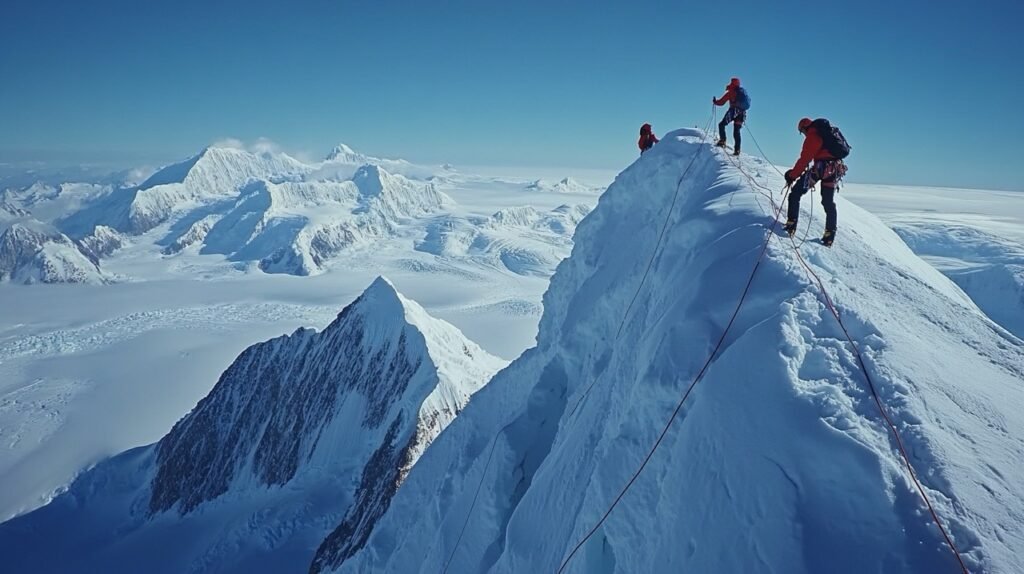
Mount St. Elias, nestled in the Wrangell-St. Elias National Park, is a playground for outdoor enthusiasts. Whether you’re into hiking, climbing, skiing, or snowboarding, this mountain promises a thrill like no other.
Hiking and Climbing
For those who love a good challenge, hiking and climbing Mount St. Elias is a dream come true. Standing tall at 18,008 feet, it’s one of the toughest peaks to conquer. The mountain’s steep rise from the sea makes it both intimidating and rewarding.
| Feature | Details |
|---|---|
| Elevation | 18,008 feet |
| Vertical Relief | 18,008 feet in 10 miles |
| First Ascent | 1897 |
| Success Rate | Low due to severe weather |
- Route Options: No easy way up. Climbers face crevasses and unpredictable weather.
- Historical Climbs: By 1964, only three expeditions had reached the summit. The first winter ascent was in 1996.
For more on how to gear up for this climb, check out our safety and preparation tips.
Skiing and Snowboarding
Mount St. Elias is a haven for skiers and snowboarders. The mountain shot to fame with a 2007 documentary about a team attempting the world’s longest ski descent.
- Longest Descent: Almost 18,000 feet down to the Gulf of Alaska.
- Terrain: The south side rises straight from the Pacific, making it stormy and windy—perfect for adrenaline junkies.
| Activity | Details |
|---|---|
| Longest Ski Descent | 18,000 feet |
| Skiing Terrain | Steep, stormy slopes |
| Best Time for Skiing | Late winter to early spring |
For those craving the ultimate ski adventure, Mount St. Elias is the place to be. Check out our guide on wrangell st. elias alaska for more tips.
Whether you’re climbing to the top or skiing down the slopes, Mount St. Elias offers an adventure you’ll never forget.
Click here to see Beautiful Hotel Options at Wrangell St. Elias
Wildlife and Nature at Mount St. Elias
Mount St. Elias, nestled in the Wrangell-St. Elias National Park and Preserve, is a treasure trove of nature’s wonders. This place is a paradise for anyone who loves the great outdoors. Let’s dive into the amazing plants and animals you might bump into and the efforts to keep this place as wild and beautiful as it is.
Plants and Animals
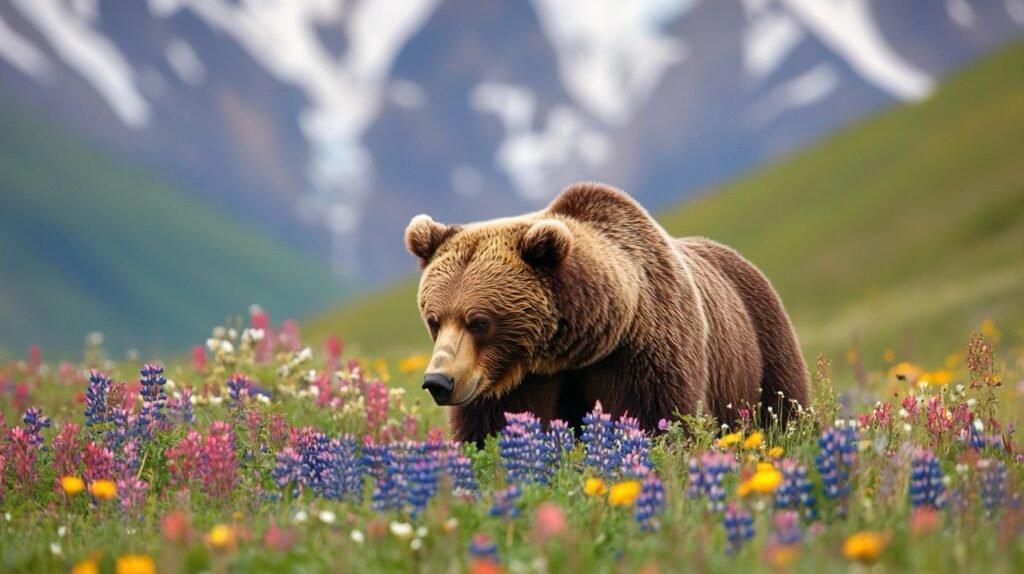
The area around Mount St. Elias is like a giant, living museum. As you wander the trails, keep an eye out for:
Plants:
- Boreal Forests: Think spruce, birch, and poplar trees.
- Alpine Tundra: Home to tiny shrubs, mosses, and lichens.
- Wetlands: Filled with sedges, willows, and marsh grasses.
Animals:
- Mammals: You might spot grizzly bears, Dall sheep, moose, and wolves.
- Birds: Look up to see bald eagles, peregrine falcons, and ptarmigans.
- Marine Life: Near the coast, you could see seals, sea lions, and even humpback whales.
Here’s a quick look at some of the wildlife:
| Wildlife Type | Common Species |
|---|---|
| Mammals | Grizzly bear, Dall sheep, Moose, Wolf |
| Birds | Bald eagle, Peregrine falcon, Ptarmigan |
| Marine Life | Seal, Sea lion, Humpback whale |
For more details about the park’s ecosystem, check out our page on Wrangell St. Elias National Park.
Keeping It Wild
Keeping Mount St. Elias wild and wonderful takes a lot of work. The folks at Wrangell-St. Elias National Park and Preserve are on it with several key projects:
- Habitat Protection: They’re making sure the natural homes of plants and animals stay untouched by human hands.
- Research and Monitoring: Scientists are always studying the park to understand how things like climate change and earthquakes affect it.
- Visitor Education: Programs and signs help visitors learn about conservation and how to enjoy the park without messing it up.
- Wildlife Protection: Rules are in place to protect endangered species and keep the park’s ecosystems in balance.
These efforts are crucial to keeping Mount St. Elias as stunning as it is. Want to know more about what they’re doing and how you can help? Visit our page on the largest national park in the United States.
By respecting the plants and animals, you can have an awesome and eco-friendly adventure in one of the most breathtaking spots on Earth.
Click here to see Beautiful Hotel Options at Wrangell St. Elias
Tips for Visiting
Mount St. Elias, nestled in the awe-inspiring Wrangell-St. Elias National Park, promises jaw-dropping views and heart-pounding adventures. To make your trip unforgettable, here’s when to go and how to stay safe.
Best Time to Visit
Picking the right time to visit Mount St. Elias can make or break your trip. It all boils down to what you want to do.
| Season | Best Activities | Weather Conditions |
|---|---|---|
| Summer (June – August) | Hiking, Climbing | Mild temperatures, minimal snow |
| Winter (December – February) | Skiing, Snowboarding | Cold, heavy snowfall, challenging conditions |
- Summer (June – August): Perfect for hiking and climbing. The weather is usually mild, and there’s less snow, making it safer and easier to get around.
- Winter (December – February): Great for skiing and snowboarding, but be warned—conditions are tough with heavy snow and freezing temps. Only for the brave and experienced.
For more on the park’s climate, visit Wrangell-St. Elias Alaska.
Safety and Preparation
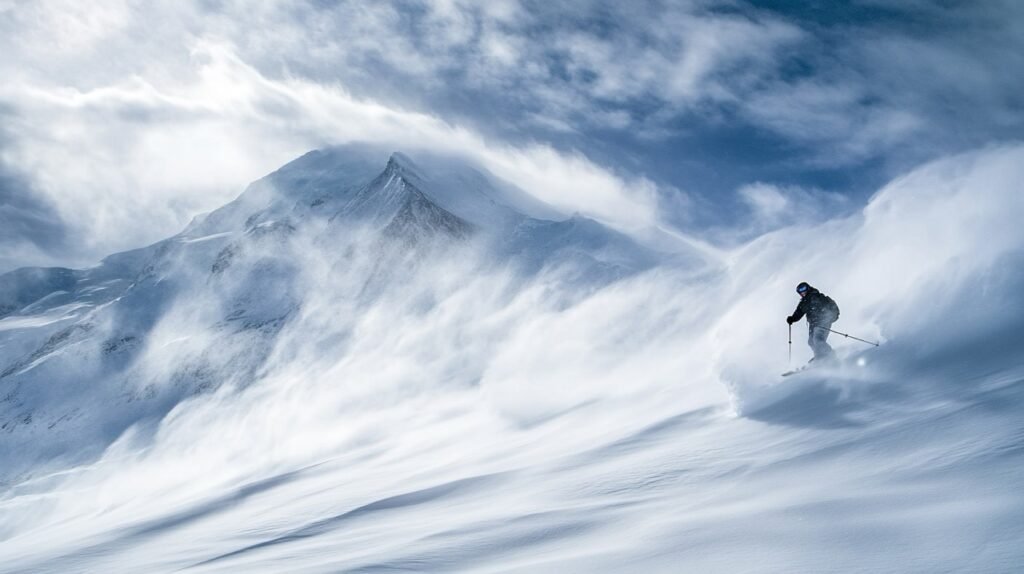
Safety first, folks! Mount St. Elias is no joke with its tricky terrain and unpredictable weather. Here’s how to stay safe:
- Proper Gear: Pack the right stuff for your adventure. Climbers need ropes, pitons, and solid clothing. Skiers and snowboarders, make sure you’re bundled up and have all your safety gear.
- Weather Check: Always check the weather before heading out. The mountain is notorious for sudden storms and strong winds thanks to its Pacific Ocean neighbor.
- Get Fit: The terrain is tough. Make sure you’re in good shape to handle the physical demands.
- Guided Tours: Think about hiring a local guide or joining a tour, especially if you’re new to the area. They know the ropes and can keep you safe.
- Emergency Plan: Have a backup plan. Know where the nearest medical facilities are and carry a communication device for emergencies.
Recent Expeditions and Documentaries
Mount Saint Elias has recently gained attention through the release of Summit Fever – The FIFTY | Mt. St. Elias – Climbing & Skiing a Mythical Mountain, a documentary by The Fifty Project. This film features climbers Cody Townsend, Dan Corn, Nick Russell, and Bjarne Salen as they tackle the challenges of this remote and rarely attempted peak.
The documentary highlights the mountain’s harsh weather conditions and the brief weather windows that climbers must navigate.In addition to this, the mountain’s ski history continues to evolve. Notably, in 2021, Brett Carroll and Gregg Hewitt attempted a sea-to-summit-to-sea expedition.
Their journey involved climbing from sea level to the summit, followed by a partial ski descent with intermittent rappels and downclimbing, showcasing the mountain’s demanding terrain.
For more prep tips, check out our article on the largest national park in the United States.
Follow these tips, and you’re set for an epic adventure at Mount St. Elias. Happy exploring!
Latest Updates and News
Mount St. Elias, the second-highest peak in both the United States and Canada, continues to captivate adventurers and researchers alike. Recent developments have shed new light on this majestic mountain and its surrounding environment.
Climate Research
Scientists have intensified their studies around Mount St. Elias, using advanced monitoring equipment to track glacial movements and weather patterns. These efforts are providing valuable insights into the impacts of climate change on high-altitude ecosystems.
Climbing Achievements
In recent years, Mount St. Elias has seen a surge in climbing expeditions. A notable ascent in 2023 set a new speed record for reaching the summit, highlighting the mountain’s enduring appeal to elite mountaineers. However, authorities emphasize the need for proper preparation and respect for this challenging peak.
Conservation Efforts
The Wrangell-St. Elias National Park, home to Mount St. Elias, has implemented new conservation measures to protect the fragile alpine environment. These include stricter waste management policies for climbers and increased monitoring of wildlife populations in the area.
Virtual Exploration
For those unable to visit in person, new high-resolution imagery and 3D mapping of Mount St. Elias are now available online. These resources allow virtual explorers to experience the mountain’s grandeur from the comfort of their homes, while also serving as valuable tools for researchers and climbers planning future expeditions.
Tourism Impact
The growing interest in Mount St. Elias has led to increased tourism in nearby communities. Local authorities are working to balance economic opportunities with environmental preservation, ensuring sustainable growth that benefits both visitors and residents while protecting the pristine wilderness surrounding this iconic peak.
